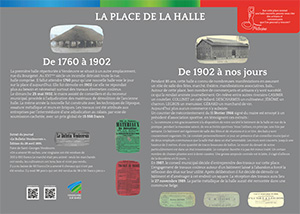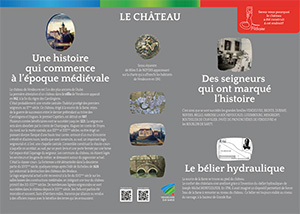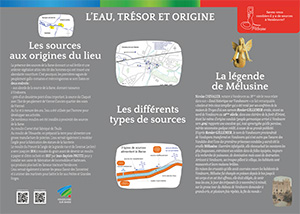Voici les différents panneaux du circuit patrimonial Mélusine :
Place de la Halle
The Place de la Halle
There was once a covered market hall in Vendeuvre, can you name some of the craftsmen and traders who worked there?
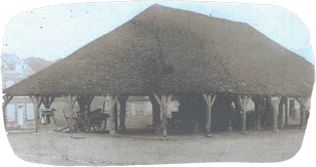
From 1760 to 1902
The first known covered hall in Vendeuvre was located Rue du Bourgetet. A fire destroyed the entire street, including the hall during the 16th century. It was not until 1760 that a new covered hall was built only to be demolished in 1902 as it no longer met demands and mainly required extremely costly maintenance work.
On Sunday 25 May 1902, the mayor, assisted by councillors and the Municipal Treasurer, proceeded with the adjudication of the materials for the demolition of the old covered hall. That same year, a new structure was erected combining a metal frame and brick walls in accordance with the techniques of the time
The work was conferred to contractors through a sealed bidding process with an overall price of 15,598 French francs.

Extract from the ‘Le Bulletin Vendeuvrois’ newspaper.
Issue dated 28 April 1895.
Fair of Saint-Georges, Vendeuvre.
‘We came with 95 cows, about twenty were sold for 300 to 450 francs. The market was rather quiet: only the farmers sold, the growers held up and did not sell.
There was a drop of 40 francs. We brought 6 horses which were not sold. There were 88 pigs which were sold between 38 to 50 francs a piece.’
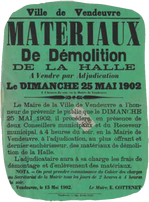
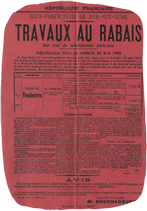
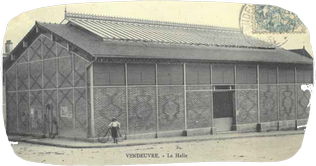
From 1902 to the present day
This covered hall has hosted numerous events for the past 85 years, providing a venue for festivals, markets, plays, community events, and dances…
A number of traders and craftsmen worked in the lively hall on a daily basis. Amongst locals were CASIMIR, a cutler; COLLINET, a café and billiards parlour; DESCHARMES, a grower; JÉRÔME, a wheelwright; LEGROS, a carpenter, and GÉRARD, a wine merchant.
Nowadays, there are no longer any businesses left.
A letter of discontent dated 11 February 1966 signed by the mayor and addressed to the president of a sports association, as shown in the following extracts:
‘... The commune has graciously made the hall available to your association for the practice of sports activities during the cold season. You generally use this building once a week. The hall is also used as a party and assembly venue, and dances are often held there. However, today, in the presence of a municipal councillor and two municipal employees, I noticed the hall to be in a pitiful state. The walls are covered with a multitude of muddy ball marks, some up to 2 metres high. The low wall at the front of the stage more specifically is in an appalling state. The refreshment station has also been treated poorly. A number of folding chairs are partly broken. A big central light bulb is blown, this is actually the second one in a fortnight…’
In 1987, the city council decided to carry out work on the site.
Undertaking costly work on a neglected structure forced the elected representatives to consider its purpose. After much deliberation, the decision was made to demolish the building and establish a square in its place. The work was completed on 27 November 1989. The metallic parts of the hall are said to have been remounted in a Belgian municipality.



Voici les différents panneaux du circuit patrimonial Mélusine :
Place de la Halle
version Enfants
Le circuit patrimonial Mélusine version Enfants a été créé sur l'application GuidiGO (GuidiGO Inc.) - circuit Mélusine
Voici les différents panneaux du circuit patrimonial Mélusine :
Château
The Château
Do you know why the château was originally built on its specific location?
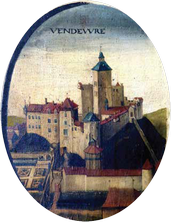
A history rooted in mediaeval times
The château de Vendeuvre is among the longest-standing in the Aube region.
The first evidence of a château in the villa of Vendeuvre dates from 962 B.C., at the end of the Carolingian reign.
It was almost certainly a ‘castle mound’, a sheltered dwelling for the first lords in the 10th century. This château, erected near the source of the Barse River, was the focus of the war for succession between the last Carolingian pretender to the throne and Hugh Capet. It was destroyed in 987 B.C.
Several counts passed on their titles to their heirs until 1221. The seigniory was subsequently taken over by Hugh, Count of Champagne and Master of Troyes. To the north of the castle mound, a powerful dungeon with a high square tower was erected during the 12th and 13th centuries, featuring an indented surrounding wall and several other towers. A large seigniorial dwelling was built to the south, and a chapel was constructed to the east. Together they formed the ‘high court’ which was accessed from the south across a drawbridge and through a gate closed by a portcullis. This space was the lord’s prerogative. The outhouses of the château, where servants and tradesmen were lodged, were constructed around the existing dovecote. This was known as the ‘low court’. The fortress was taken apart in the second half of the 17th century, in accordance with Cardinal Richelieu’s 1626 edict ordering the destruction of feudal castles.
The present-day seigniorial dwelling was reconstructed at the end of the 17th century on the lower parts of the mediaeval buildings, incorporating a tower from the original 12th-13th-century château.
Many lordly lineages have succeeded one another in the château since the 13th century. Its fiefs have on occasion been fragmented and often, for want of male heirs, passed on by marriage or sold to regal officers alongside all the benefits of the surrounding lands.
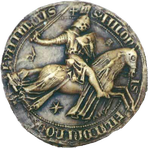
Equestrian Seal of Miles X. de NOYERS as it appears on the charter that freed the inhabitants of Vendeuvre in 1341.
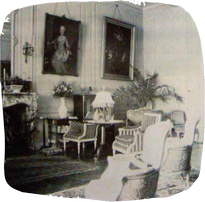
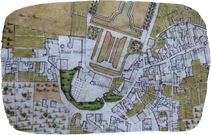
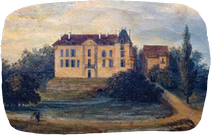
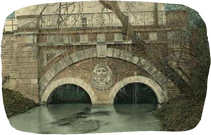
Lords who made history
Thus, prominent families succeeded one another: The VENDEUVRE, BROYES, DURNAY, NOYERS, MELLO, AMBOISE LA ROCHEFOUCAUD, LUXEMBOURG, MESGRIGNY, BOUTHILIER DE CHAVIGIER, PAVÉE DE PROVENCHÈRES DE VENDEUVRE, and the BOURLON DE SARTY.
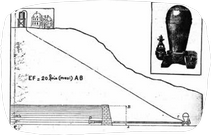
The hydraulic ram
The source of the Barse River lies at the foot of the château.
The comfort of the lords improved when Joseph-Michel MONTGOLFIER invented the ‘hydraulic ram’ in 1796. He imagined a device to force the water of the Barse River to rise up to the level of the château which can still be seen today, just off the Grande Rue.
Voici les différents panneaux du circuit patrimonial Mélusine :
Château
version Enfants
Le circuit patrimonial Mélusine version Enfants a été créé sur l'application GuidiGO (GuidiGO Inc.) - circuit Mélusine
Voici les différents panneaux du circuit patrimonial Mélusine :
Eau, Trésor et Origine
Water, Treasure and Origins
Do you know how many sources there are in Vendeuvre?
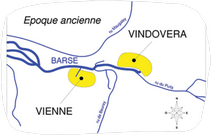
Sources at the root of the site
The rich soil and lush vegetation afforded by the Barse sources attracted people to the area very early on, providing them with an abundance of food. As a result, the early Gallo-Roman and Merovingian population waves settled in two main areas:
- in the vicinity of the Barse River source, spawning Vindovera;
- near another major water supply, the Claquot source, with the Vienna settlement cluster (the former Voies de Vienne district).
Over the years, people exploited the water to develop their activities.
Several mills (moulins in French) were built in close proximity to the Barse sources.
Oil was produced at the Moulin Cornet.
While the soil was processed to supply a large pottery factory at the Moulin de l’Houzotte. The water also helped to model the clay for the ‘Sainterie’ statues.
The Moulin du Prieuré (the Priory mill) located at the intersection of the Grande Rue and Avenue Leclerc, crushed grain until 1814 before becoming a paper mill. In 1837, Jean-Baptiste PROTTE purchased the mill to house his traction engine and thresher manufacturing plant which later produced the renowned Vendeuvre tractors.
The water was also used to tan hides at the lavoir des tanneries (tannery washhouse) and to power the iron-beating swifts at the Petites and Grandes Forges (Small and Large Forges).
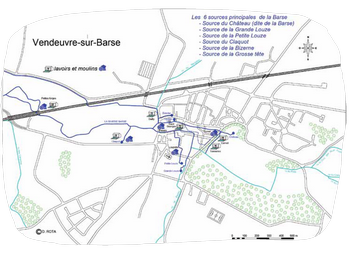
The six key Barse sources
- Source du Château (so-called Source de la Barse)
- Source de la Grande Louze
- Source de la Petite Louze
- Source du Claquot
- Source de la Bizerne
- Source de la Grosse tête
Washhouses and mills
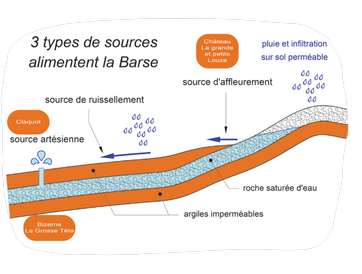
The different types of sources
3 types of sources supply the Barse
Claquot
Bizerne La Grosse Tête
Château La grande et petite Louze
artesian source
run-off source
outcrop source
impervious clays
water-saturated rock
rain and infiltration on porous soil
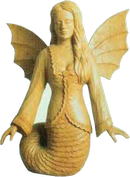
The legend of Melusine
Nicolas CHEVALIER, a notary in Vendeuvre in the 18th century, related an astonishing occurrence in his ‘Historical essay on Vandoeuvre’.
‘Renier GILLEMER, a former and elderly Templar disavowed by his brethren of the house of Troyes, a hermit residing in a clearing of the forêt d’Orient, north of Vendeuvre, in the 12th century, himself of vandal origin (a Germanic people who settled in Vendeuvre around 409 B.C.), recounts an anecdote which, while seemingly apocryphal, nonetheless merits some credit owing to its wide promotion.
According to Renier GILLEMER, the name Vandoeuvre is believed to be derived from Vandopera changed to Vandovera which is none other than the work of the Vandals. One of the very first Vandal princesses is said to have been the ruthless Melusine.
A tireless warrior, she rode the fiercest of mounts, leading her soldiers on wild expeditions, in relentless pursuit of power, domination, and devastation. Upon arriving in Vendeuvre, her troops plundered the village, slaughtered its inhabitants, and burned their houses.
On account of the many horrors that she had inflicted on the people of Vendeuvre, Melusine was turned into a fish from the waist down and forced to appear on the big tower of the Château de Vendeuvre in this dreadful state, each year, on the day of the dead (November 2nd), to beg for the end of the world through great and repeated screams.’
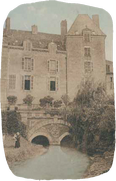
Voici les différents panneaux du circuit patrimonial Mélusine :
Eau, Trésor et Origine
version Enfants
Le circuit patrimonial Mélusine version Enfants a été créé sur l'application GuidiGO (GuidiGO Inc.) - circuit Mélusine





